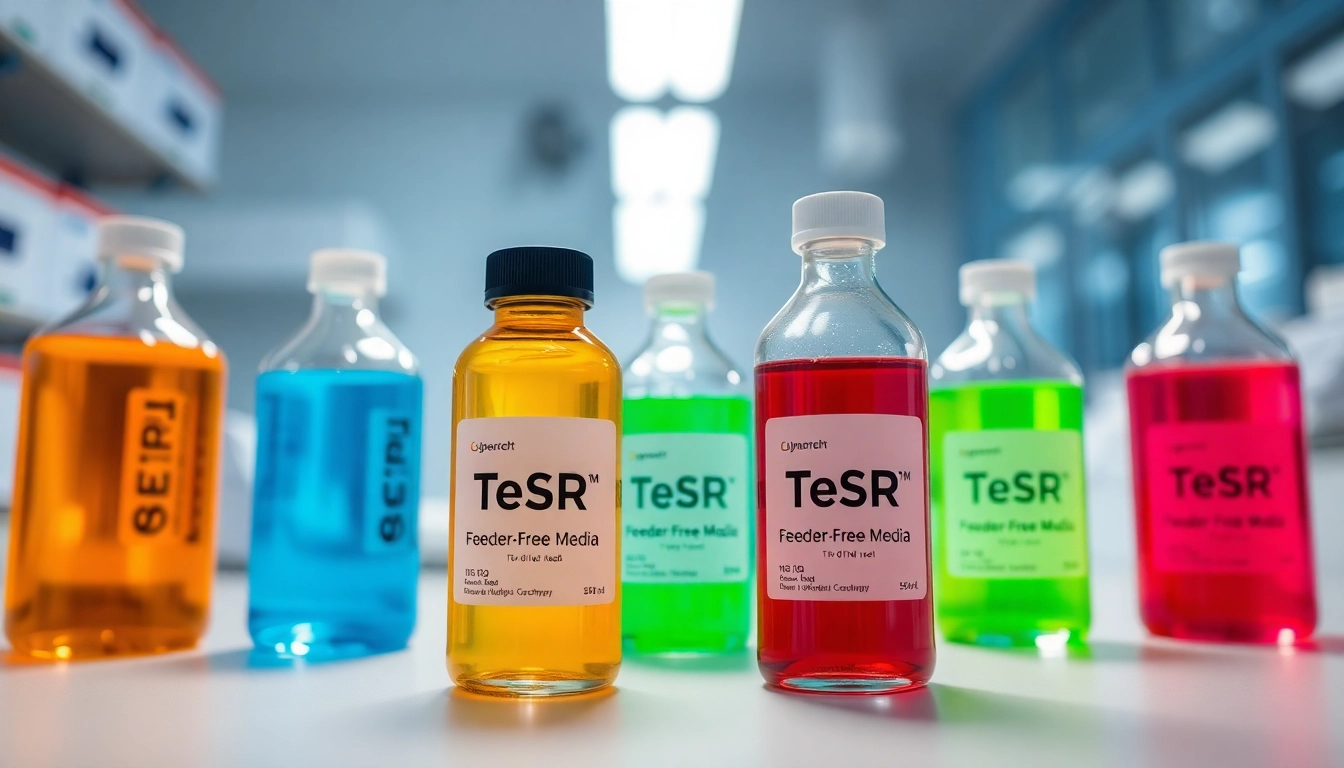Understanding TeSR™ Media and Their Importance
Pluripotent stem cells (PSCs) have gained immense attention due to their ability to differentiate into various cell types, making them invaluable in regenerative medicine and developmental biology research. However, the success of PSC research is heavily dependent on the conditions under which these cells are cultured. This is where feeder-free culture media, specifically TeSR™ media, come into play.
TeSR™ media are designed to offer a consistent, defined environment that supports the growth and maintenance of human embryonic stem (ES) and induced pluripotent stem (iPS) cells. The TeSR™ media family is a product of rigorous scientific research and represents a significant advancement over traditional feeder-based culture methods. This section will explore the significance of TeSR™ media in the maintenance and differentiation of PSCs.
Overview of Pluripotent Stem Cells (PSCs)
Pluripotent stem cells are unique in that they can give rise to any cell type in the body, making them essential for developmental studies and the potential treatment of various diseases. PSCs are categorized primarily into two types: embryonic stem cells (hESCs), derived from early-stage embryos, and induced pluripotent stem cells (iPSCs), which are somatic cells reprogrammed back into a pluripotent state. These cells provide a powerful tool for modeling human diseases, drug discovery, and regenerative medicine.
The Role of TeSR™ Media in PSC Culture
TeSR™ media were developed in response to the inherent challenges associated with traditional stem cell culture techniques. Using feeder layers can introduce variability due to inconsistent growth factor availability and contamination risks from animal-derived components. TeSR™ media aim to eliminate these issues by providing a fully defined, xenogen-free environment that enables more reliable and reproducible cell culture.
The TeSR™ media family is flexible and includes variations suitable for different stages of stem cell research, from maintenance through to differentiation and cryopreservation. This seamless continuum enhances researcher efficiency and cell quality.
Key Components of TeSR™ Media
Each formulation in the TeSR™ media family includes a carefully curated blend of components that ensure optimal conditions for PSC culture. Key components include:
- Growth factors: Essential for promoting cell proliferation and maintaining pluripotency, such as FGF2.
- Buffers: To maintain the pH stability of the culture medium, which is crucial for cellular health.
- Minerals: Critical for various cellular functions, ensuring that cells have the necessary nutrients for growth.
- Animal-free modifications: To reduce the risk of contamination and improve safety profiles in research and clinical applications.
Types of TeSR™ Media and Their Applications
The TeSR™ family encompasses a variety of formulations, each tailored for specific purposes in stem cell research. Understanding these variations is critical for selecting the appropriate medium for your specific research needs.
Comparing mTeSR™ Plus to Other Media
mTeSR™ Plus is a prominent member of the TeSR™ family, renowned for its enhanced formulation. Unlike traditional media, mTeSR™ Plus offers improved buffering capacity, which helps maintain cell health during extended culture periods, especially during skipped media changes. This formulation incorporates stabilized growth factors and reduces pH fluctuations, enhancing overall cell viability and functionality.
Other media options, such as mTeSR™1, also provide effective solutions but may not incorporate the same level of enhancements necessary for longer-term cultures. Thus, researchers should carefully consider their specific requirements when selecting a medium for their experiments.
Application Scenarios for TeSR™-E8™
TeSR™-E8™ is designed for maintenance of hPSCs and offers a simplified formulation with only the essential components required for optimal growth. This medium is particularly beneficial in settings where minimizing protein content is crucial, which may be relevant in high-throughput applications or when preparing cells for downstream differentiation.
Furthermore, TeSR™-E8™ is widely recognized for its usability across various stem cell lines and may serve as an excellent choice for labs focusing on versatile PSC applications.
Advantages of Using ReproTeSR™ for Reprogramming
ReproTeSR™ is specifically formulated for reprogramming somatic cells into iPSCs. Its optimized composition promotes efficient conversion while maintaining pluripotency. One key advantage is its flexibility in reprogramming various cell types, including fibroblasts and blood cells, which helps streamline workflows in generating patient-specific iPSCs.
Researchers using ReproTeSR™ have reported notable efficiencies in achieving high-quality, pluripotent colonies, underscoring the significance of using well-optimized media during critical experimental phases.
Quality Control in TeSR™ Media Production
Ensuring the quality of culture media is paramount for maintaining consistent experimental results. The TeSR™ media undergo rigorous production standards that enhance their reliability in scientific research.
Batch Consistency and Reproducibility Checks
One of the critical aspects of TeSR™ media is their rigorous batch-to-batch consistency. Each batch is produced using pre-screened materials and undergoes extensive testing to ensure that it meets the strict quality standards established by regulatory agencies. This consistency allows researchers to reproduce their experiments with confidence, minimizing unwanted variability due to media inconsistencies.
Regulatory Compliance: Understanding cGMP
The production of TeSR™ media adheres to current Good Manufacturing Practice (cGMP) guidelines. This includes regular monitoring and documentation of manufacturing processes, ensuring quality at every step. Compliance with these regulations not only enhances the safety and effectiveness of stem cell research but also prepares labs for potential clinical applications that may arise from their research.
Ensuring Purity with Animal Origin-Free Formulations
Purity is a critical consideration when developing culture media. Animal origin-free formulations, such as TeSR™-AOF, guarantee that the products are free from human and animal-derived components to a secondary level of manufacturing. This significantly reduces the risk of contamination by pathogens and enhances the safety profile of the media for both research and potential therapeutic applications.
Challenges in Differentiation and Scale-Up Cultures
While TeSR™ media offer significant advantages, challenges remain, particularly regarding the differentiation of PSCs and scaling up cultures for larger applications.
Key Issues in Maintaining Cell Line Quality
Maintaining the quality of PSCs during differentiation is crucial for obtaining functional cell types specific to research needs. Challenges such as loss of pluripotency, improper cell maturation, and variations in differentiation protocols can affect outcomes. Researchers must employ robust monitoring techniques to ensure that cells maintain their required characteristics throughout differentiation processes.
Bioreactor Culture Techniques Overview
Bioreactor systems offer an innovative solution for scaling up PSC cultures. These systems allow for large-scale production of PSCs while maintaining optimal culture conditions. Techniques such as stirred-tank bioreactors or wave-driven systems can provide the controlled environment necessary for the consistent maintenance of cell quality.
However, the transition to bioreactor systems poses its own challenges, including mechanics of shear stress and nutrient distribution, which need to be appropriately managed to optimize cell health during growth and differentiation.
Case Studies in Successful Differentiation
There are numerous case studies exploring the successful differentiation of PSCs using TeSR™ media. For instance, researchers have reported differentiated cardiomyocytes from iPSCs grown in mTeSR™ media, demonstrating functional properties comparable to native heart cells. Such findings highlight the potential of tailored media formulations to support complex differentiation pathways.
Furthermore, studies focusing on hematopoietic differentiation have shown promising results by integrating specific growth factor cocktails with TeSR™ media, resulting in robust generation of hematopoietic progenitors from iPSCs.
Future Directions in PSC Research and TeSR™ Media
The field of PSC research is rapidly evolving, with new technologies and methodologies continuously emerging. As this field grows, the development and refinement of culture media like TeSR™ will play a pivotal role in advancing our understanding and applications of stem cells.
Emerging Technologies in Stem Cell Research
Recent advancements in genetic engineering technologies, such as CRISPR/Cas9, present significant opportunities for PSC research. The integration of these technologies with optimized culture media can lead to more precise modifications and better insights into gene function and regulation during differentiation processes.
Additionally, 3D culture systems and organoid technology are gaining traction, allowing researchers to model complex tissues more accurately. The scalability of TeSR™ media formulations within these platforms could revolutionize stem cell applications in drug development and disease modeling.
Exploring New Formulations and Their Benefits
As the needs of researchers become more specialized, there will likely be an ongoing demand for new formulations within the TeSR™ media family. Future developments may focus on enhancing specific endpoints like maturation efficiency or viability during cryopreservation. These advancements will provide researchers with greater flexibility and control over their experimental designs.
Setting Standards for Future Media Development
To ensure that future media meet the high standards required for PSC research, collaborative efforts between scientists, industry leaders, and regulatory bodies will be necessary. Establishing standardized practices for the design, testing, and validation of new culture media will lead to improved reliability and reproducibility across stem cell research fields.



